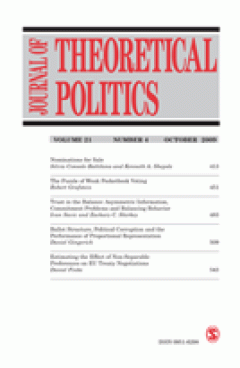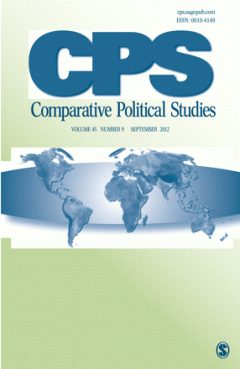Filter by

Who selects the party leader
We study the degree of formal influence that rank-and-file members have on the selection of party leaders in the five English-speaking Westminster countries: Australia, Canada, Ireland, New Zealand and the United Kingdom. We find that in recent years there has been a general, though not universal, trend towards granting party members greater influence in the choice of their leader. We observe t…
- Edition
- Vol. 18 no. 2, March 2012,pp. 127-150
- ISBN/ISSN
- 13540688
- Collation
- -
- Series Title
- Party Politics
- Call Number
- -

The homogeneity of West European party families : The radical right in compar…
Common concepts for the classification of parties into families (origins, transnational links, ideology, name) suggest that the radical right should be less homogeneous than most other party families in Western Europe: their comparatively diverse origins, disputed ideological core features, as well as the lack of stable transnational cooperation and the absence of an agreed-upon label support t…
- Edition
- Vol. 18 no. 2, March 2012 ,pp. 151-171
- ISBN/ISSN
- 13540688
- Collation
- -
- Series Title
- Party Politics
- Call Number
- -

Party media agenda-setting : How parties influence election news coverage
Political parties have substantial influence on which issues the news media cover during election campaigns, while the media have limited influence on party agendas. However, we know little about why some parties are more successful than others in passing the media’s gates and being covered on sponsored issues. On the basis of content analyses of election news coverage (812 news stories) and pr…
- Edition
- Vol. 18 no. 2, March 2012,pp. 173-191
- ISBN/ISSN
- 13540688
- Collation
- -
- Series Title
- Party Politics
- Call Number
- -

Party and gender in Western Europe revisited : A fuzzy-set qualitative compar…
Scholars of women’s parliamentary presence have suggested that the proportion of women parliamentarians rests on the interaction between intra-party and party external conditions, and that these can be discussed in terms of necessity and sufficiency. Still, the field lacks systematic cross-case assessments of such relationships. This research takes an explorative approach to necessity, sufficie…
- Edition
- Vol. 18 no. 2, March 2012, pp. 193-214
- ISBN/ISSN
- 13540688
- Collation
- -
- Series Title
- Party Politics
- Call Number
- -

When citizens go against elite directions : Partisan cues and contrast effect…
While much research has investigated the persuasive effects of partisan cues on citizens’ evaluations of political messages, our knowledge regarding failed persuasion is limited. It remains particularly unclear whether failed elite attempts at persuasion simply leave citizens’ attitudes unchanged or whether such attempts at persuading one segment of the electorate can actually lead to a loss of…
- Edition
- Vol. 18 no. 2, March 2012,pp. 215-233
- ISBN/ISSN
- 13540688
- Collation
- -
- Series Title
- Party Politics
- Call Number
- -

Party system types and party system institutionalization : Comparing new demo…
This article is an overview of the types and level of institutionalization of party systems in seven young democracies in East and Southeast Asia. By applying Alan Siaroff’s typology of party systems, the analysis demonstrates that the party systems in Asia do not converge on a single format. The party systems under consideration also differ in the level of institutionalization. Party systems i…
- Edition
- Vol. 18 no. 2, March 2012,pp. 235-265
- ISBN/ISSN
- 13540688
- Collation
- -
- Series Title
- Party Politics
- Call Number
- -

A backroom without the smoke? Superdelegates and the 2008 Democratic nominati…
This article is an examination of the candidate preferences of 2008 superdelegates and of their role in determining the eventual Democratic nominee. Multivariate analysis suggests that female superdelegates were less likely to support Obama than were men; African-Americans, in contrast, were more likely to support his candidacy. A higher percentage of the popular vote received by Obama in the p…
- Edition
- Vol. 18 no. 2, March 2012,pp. 267-283
- ISBN/ISSN
- 13540688
- Collation
- -
- Series Title
- Party Politics
- Call Number
- -

Bargaining and the effectiveness of international criminal regimes
International institutions lack the independent ability to punish non-compliance, but states sustain cooperation because they can target one another for punishment. In contrast, international criminal courts and tribunals (ICTs) can enforce rulings once suspects are in custody, but they lack the independent power of capture, leaving them unable to punish alleged criminals and therefore deter cr…
- Edition
- Vol. 24 no. 2, April 2012,pp. 149-171
- ISBN/ISSN
- 09516298
- Collation
- -
- Series Title
- Journal of Theoretical Politics
- Call Number
- -

Demystifying trust : Experimental evidence from Cambodia and Thailand
We report the results of a trust survey and public goods experiment conducted with high school students in rural Thailand and Cambodia that together help clarify the dynamics at work in sustaining economic cooperation within these two third-world communities. We find that standard survey measures of trust employed by the World Values Survey, which form the basis of most macro-empirical investig…
- Edition
- Vol. 24 no. 2, April 2012, pp. 172-209
- ISBN/ISSN
- 09516298
- Collation
- -
- Series Title
- Journal of Theoretical Politics
- Call Number
- -

Dictatorship in a single export crop economy
We provide an analysis of a power-maximising model for dictatorial behaviour. In the model, the dictator’s revenues depend on the exports of a single crop. Using export earnings the dictator buys loyalty from the producers of the export crop by setting the domestic producer price. Revenues resulting from the difference between the international and the domestic price of the crop are used to fin…
- Edition
- Vol. 24 no. 2, April 2012,pp.210-234
- ISBN/ISSN
- 09516298
- Collation
- -
- Series Title
- Journal of Theoretical Politics
- Call Number
- -

Probabilistic voting equilibria under nonlinear candidate payoffs
The ‘mean voter theorem’ implies that candidates should choose identical policy positions in a two-candidate race if voting is probabilistic. This result is in fact an artifact of the assumption that the candidates maximize expected vote share or probability of win, which is not true for many real-world elections. In this paper I analyze a probabilistic voting model in which the candidates have…
- Edition
- Vol. 24 no. 2, April 2012.pp. 235-247
- ISBN/ISSN
- 09516298
- Collation
- -
- Series Title
- Journal of Theoretical Politics
- Call Number
- -

Why does the majority party bother to have minority party members on committees?
Why would a generic parliament have committees with minority party members? If the majority party considers minority party committee members a burden, then it could choose to exclude minority party members entirely from the committee system. This, however, has rarely happened in history. In this paper, I provide an informational rationale for the bipartisan committee system through a simple sig…
- Edition
- Vol. 24 no. 2, April 2012,pp. 248-264
- ISBN/ISSN
- 09516298
- Collation
- -
- Series Title
- Journal of Theoretical Politics
- Call Number
- -

Groseclose and Snyder in finite legislatures
The Groseclose and Snyder (1996) model is one of the best-known models of vote buying in legislatures. Although the logic of the model is compelling, it is not clear that its key propositions, derived in a continuous set-up, hold in finite legislatures. This is an important issue because many real-world legislatures are small and should be modeled as finite in order to make predictions on coali…
- Edition
- Vol. 24 no. 2, April 2012,pp. 265-273
- ISBN/ISSN
- 09516298
- Collation
- -
- Series Title
- Journal of Theoretical Politics
- Call Number
- -

Managing expectations
Followers of law, politics and business commonly relate stories of individuals who appear to predict an expected performance level below what they believe themselves to be capable of. The standard explanation for such rhetoric is that it hedges against the negative consequences of unanticipated failures and takes advantage of unexpected successes. Although the strategy appears highly attractive…
- Edition
- Vol. 24 no. 2, April 2012,pp. 274-302
- ISBN/ISSN
- 09516298
- Collation
- -
- Series Title
- Journal of Theoretical Politics
- Call Number
- -

Leaning Right and Learning From the Left : Diffusion of Corporate Tax Policy …
There is an increased focus in comparative politics and international relations on how choices of governments are dependent on choices made by other governments. The authors argue that although the relationship between policy choices across countries is often labeled as either diffusion or competition, in many cases the theoretical mechanisms underpinning these labels are unclear. In this artic…
- Edition
- Vol. 45 no. 3, March 2012,pp. 283-311
- ISBN/ISSN
- 00104140
- Collation
- -
- Series Title
- Comparative Political Studies
- Call Number
- -

Fragile Snapshot or Stable Relationships? : What the Orange and Rose Revoluti…
One of the long-standing criticisms of cross-sectional survey data is that they provide only a contextually driven “snapshot” of attitudes. These attitudes are, the “snapshot critique” contends, highly fragile—subject to significant fluctuation based on events that arise domestically and globally. Although it makes sense that a major event can alter the percentage of people who respond to a giv…
- Edition
- Vol. 45 no. 3, March 2012,pp. 312-340
- ISBN/ISSN
- 00104140
- Collation
- -
- Series Title
- Comparative Political Studies
- Call Number
- -

An Irrational Party of Rational Members : The Collision of Legislators’ Ree…
This study presents a new explanation to a puzzle regarding the reluctance of the Japan Socialist Party (JSP) to moderate its hard-liner Marxist platform. The author does so by focusing on the preferences and strategies of individual JSP members, in contrast to previous studies that treat the party as a unitary actor. The author shows that Japan’s electoral system created a unique environment i…
- Edition
- Vol. 45 no. 3, March 2012 ,pp. 341-365
- ISBN/ISSN
- 00104140
- Collation
- -
- Series Title
- Comparative Political Studies
- Call Number
- -

The Political Effectiveness of Terrorism Revisited
Terrorists attack civilians to coerce their governments into making political concessions. Does this strategy work? To empirically assess the effectiveness of terrorism, the author exploits variation in the target selection of 125 violent substate campaigns. The results show that terrorist campaigns against civilian targets are significantly less effective than guerrilla campaigns against milit…
- Edition
- Vol. 45 no. 3, March 2012,pp. 366-393
- ISBN/ISSN
- 00104140
- Collation
- -
- Series Title
- Comparative Political Studies
- Call Number
- -

Assessing the Impact of Lustration on Trust in Public Institutions and Nation…
Lustration is alternately theorized and anecdotally alleged to either undermine or contribute to the democratic transitions in Central and Eastern Europe (CEE) by supporting or undermining trust in public institutions, and by extension trust in national government. Using quantitative data on nine countries in CEE, this study examines the impact of lustration and transitional justice measures on…
- Edition
- Vol. 45 no. 4, April 2012,pp. 412-446
- ISBN/ISSN
- 00104140
- Collation
- -
- Series Title
- Comparative Political Studies
- Call Number
- -

Combining Federalism and Decentralization : Comparative Case Studies on Regio…
Studies evaluating the effects of territorial state organization on the performance of democratic political systems produce ambiguous results. The authors argue that research so far has suffered from insufficiently conceptualizing federalism and decentralization as two distinct dimensions. This article makes use of the advantages of a nested design and detects micro-level causal mechanisms unde…
- Edition
- Vol. 45 no. 4, April 2012,pp. 447-476
- ISBN/ISSN
- 00104140
- Collation
- -
- Series Title
- Comparative Political Studies
- Call Number
- -
 Computer Science, Information & General Works
Computer Science, Information & General Works  Philosophy & Psychology
Philosophy & Psychology  Religion
Religion  Social Sciences
Social Sciences  Language
Language  Pure Science
Pure Science  Applied Sciences
Applied Sciences  Art & Recreation
Art & Recreation  Literature
Literature  History & Geography
History & Geography